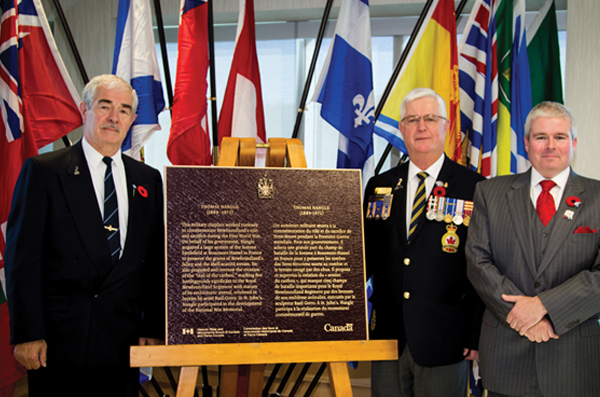
At the unveiling of a plaque commemorating Thomas Nangle are (from left) historian Gary Browne, Newfoundland and Labrador Command President Frank Sullivan and historian Dr. John Fitzgerald. [Frank Gogos]
A new plaque was unveiled in St. John’s, N.L., in November by the Historic Sites and Monuments Board of Canada, recognizing Thomas Nangle, the tireless padre of the Newfoundland Regiment, as a person of national historic significance.
The unveiling took place in the Surgeon Lieutenant-Commander Anthony Paddon Building at Canadian Forces Station St. John’s during the 100th anniversary of the attack on Beaumont-Hamel, where the regiment suffered tremendous losses on the first day of the Battle of Somme.
Lieutenant-Colonel Thomas Nangle was the popular padre of the Royal Newfoundland Regiment in the later part of the First World War. He was born in St. John’s in 1889 and was ordained in 1913.
The archbishop of Newfoundland had denied his request to join the Newfoundland forces when war broke out in 1914. However, after the tragedy of Beaumont-Hamel on July 1, 1916, Nangle was allowed to join the British Army chaplaincy, and was posted to the regiment where he saw to the wounded, comforted families and buried the dead. He was wounded in the shoulder in 1917.
After the war, he returned to Newfoundland and was assigned to St. Michael’s Parish on Bell Island. In 1919, he was appointed Newfoundland’s representative on the Directorate of War Graves and Enquiries and the Imperial War Graves Commission. He returned to Europe where he oversaw the documenting and marking of graves for Newfoundland’s war dead.
He was later asked to find a way to commemorate Newfoundland’s contribution to the Great War. He suggested erecting a statue of a caribou, the emblem of the Newfoundland Regiment, on each of the five main battlefields where Newfoundlanders fought and died.
He worked tirelessly raising money for the project by lobbying the Newfoundland government, giving speeches and talking to the families of those who had fallen. He negotiated with more than 250 French landowners to acquire the land where the monuments were to be built.
By 1925, there were five larger-than-life bronze statues of the Newfoundland caribou: four in France at Beaumont-Hamel, Gueudecourt, Masnieres and Monchy-le-Preux, and one in Belgium at Courtrai. The statues by British sculptor Basil Gotto show the caribou staring in the direction of the enemy. Collectively, they are known as the Trail of the Caribou. The most magnificent is the Beaumont-Hamel Newfoundland National Memorial, unveiled in 1925 by Field Marshal Sir Douglas Haig.
Back in Newfoundland, Nangle was also on the Newfoundland National War Memorial Finalization Committee, playing a major role in the construction and unveiling of the National War Memorial in downtown St. John’s. It was unveiled by Haig on July 1, 1924.
When the projects were done, Nangle left the priesthood. He moved to Rhodesia, modern-day Zimbabwe, married and raised a family. He became a successful farmer and also served as a newspaper editor, a member of Parliament and mayor of the town where he lived. He died in 1972, having never returned to Newfoundland.
Local historian Gary Browne, who has co-authored a book on Nangle, was one of the main advocates for the recognition. Although Newfoundland and Labrador Command of The Royal Canadian Legion has granted permission for it to be added to the National War Memorial in St. John’s, the final site has not yet been decided.
Advertisement



















